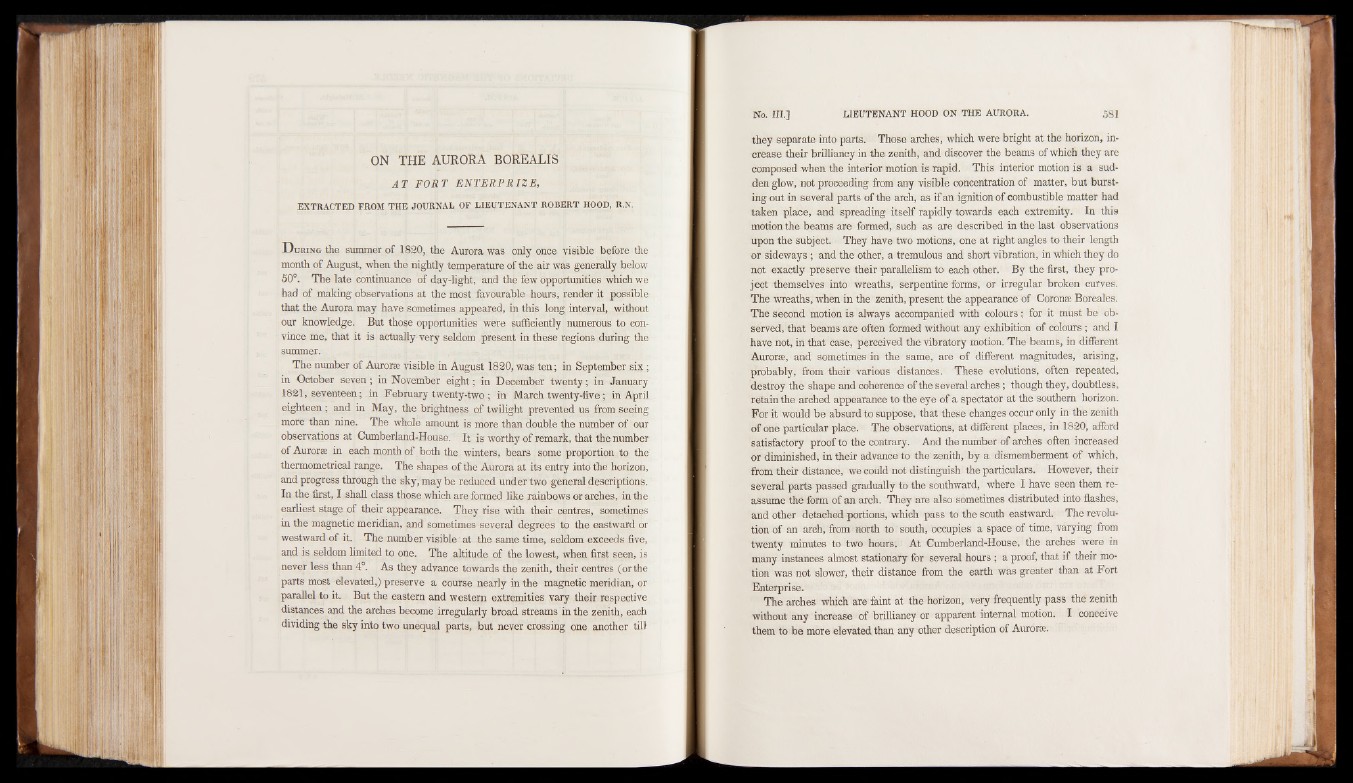
ON THE AURORA BOREALIS
A T F O R T E N T E R P R IZ E ,
EXTRACTED FROM THE JOURNAL OF LIEUTENANT ROBERT HOOD, R.N.
D uring the summer of 1820, the Aurora was only once visible before the
month of August, when the nightly temperature of the air was generally below
50°. The late continuance of day-light, and the few opportunities which we
had of making observations at the most favourable hours, render it possible
that the Aurora may have sometimes appeared, in this long interval, without
our knowledge. But those opportunities were sufficiently numerous to convince
me, that it is actually very seldom present in these regions during the
summer.
The number of Aurorae visible in August 1820, was ten; in September six;
in October seven; in November eight; in December twenty; in January
1821, seventeen; in February twenty-two; in March twenty-five; in April
eighteen ; and in May, the brightness of twilight prevented us from seeing
more than nine. The whole amount is more than double the number of our
observations at Cumberland-House. It is worthy of remark, that the number
of Aurorae in each month of both the winters, bears some proportion to the
thermometrical range. The shapes of the Aurora at its entry into the horizon,
and progress through the sky, may be reduced under two general descriptions.
In the first, I shall class those which are formed like rainbows or arches, in the
earliest stage of their appearance. They rise with their centres, sometimes
in the magnetic meridian, and sometimes several degrees to the eastward or
westward of it. The number visible' at the same time, seldom exceeds five,
and is seldom limited to one. The altitude of the lowest, when first seen, is
never less than 4°. As they advance towards the zenith, their centres (or the
parts most elevated,) preserve a course nearly in the magnetic meridian, or
parallel to it. But the eastern and western extremities vary their respective
distances and the arches become irregularly broad streams in the zenith, each
dividing the sky into two unequal parts, but never crossing one another till
they separate into parts. Those arches, which were bright at the horizon, increase
their brilliancy in the zenith, and discover the beams of which they are
composed when the interior motion is rapid. This interior motion is a sudden
glow, not proceeding from any visible concentration of matter, but bursting
out m several parts of the arch, as if an ignition of combustible matter had
taken place, and spreading itself rapidly towards each extremity. In this
motion the beams are formed, such as are described in the last observations
upon the subject. They have two motions, one at right angles to their length
or sideways ; and the other, a tremulous and short vibration, in which they do
not exactly preserve their parallelism to each other. By the first, they project
themselves into wreaths, serpentine forms, or irregular broken curves.
The wreaths, when in the zenith, present the appearance of Coron® Boreales.
The second motion is always accompanied with colours; for it must be observed,
that beams are often formed without any exhibition of colours ; and I
have not, in that case, perceived the vibratory motion. The beams, in different
Aurorae, and sometimes in the same, are of different magnitudes, arising,
probably, from their various distances. These evolutions, often repeated,
destroy the shape and coherence of the severail arches; though they, doubtless,
retain the arched appearance to the eye of a spectator at the southern horizon.
For it would be absurd to suppose, that these changes occur only in the zenith
of one particular place. The observations, at different places, in 1820, afford
satisfactory proof to the contrary. And the number of arches often increased
or diminished, in their advance to the zenith, by a dismemberment of which,
from their distance, we could not distinguish the particulars. However, their
several parts passed gradually to the southward, where I have seen them reassume
the form of an arch. They are also sometimes distributed into flashes,
and other detached portions, which pass to the south eastward. The revolution
of an arch, from north to south, occupies a space of time, varying from
twenty minutes to two hours. At Cumberland-House, the arches were in
many instances almost stationary for several hours ; a proof, that if their motion
was not slower, their distance from the earth was greater than at Fort
EnTtehrep rairsec.hes which are faint at the horizon, very frequently pass the zenith
without any increase of brilliancy or apparent internal motion. I conceive
them to be more elevated than any other description of Aurora.